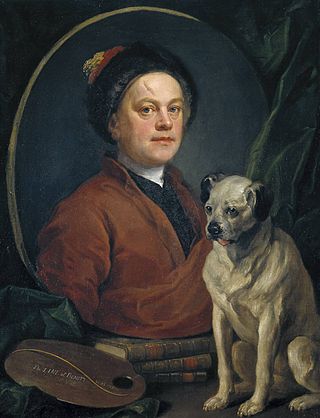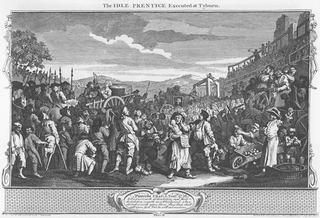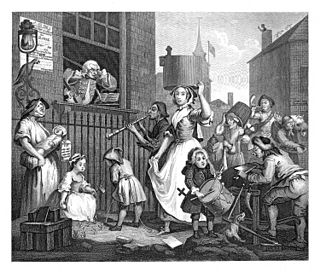
William Hogarth was an English painter, engraver, pictorial satirist, social critic, editorial cartoonist and occasional writer on art. His work ranges from realistic portraiture to comic strip-like series of pictures called "modern moral subjects", and he is perhaps best known for his series A Harlot's Progress, A Rake's Progress and Marriage A-la-Mode. Knowledge of his work is so pervasive that satirical political illustrations in this style are often referred to as "Hogarthian".

John James Heidegger was a leading impresario of masquerades in England in the early part of the 18th century.

Colley Cibber was an English actor-manager, playwright and Poet Laureate. His colourful memoir Apology for the Life of Colley Cibber (1740) describes his life in a personal, anecdotal and even rambling style. He wrote 25 plays for his own company at Drury Lane, half of which were adapted from various sources, which led Robert Lowe and Alexander Pope, among others, to criticise his "miserable mutilation" of "crucified Molière [and] hapless Shakespeare".
This article contains information about the literary events and publications of 1724.

John "Jack" Sheppard, or "Honest Jack", was a notorious English thief and prison escapee of early 18th-century London.

Robert Wilks was a British actor and theatrical manager who was one of the leading managers of Theatre Royal, Drury Lane in its heyday of the 1710s. He was, with Colley Cibber and Thomas Doggett, one of the "triumvirate" of actor-managers that was denounced by Alexander Pope and caricatured by William Hogarth as leaders of the decline in theatrical standards and degradation of the stage's literary tradition.

Industry and Idleness is the title of a series of 12 plot-linked engravings created by William Hogarth in 1747, intending to illustrate to working children the possible rewards of hard work and diligent application and the sure disasters attending a lack of both. Unlike his earlier works, such as A Harlot's Progress (1731) and Marriage à-la-mode (1743), which were painted first and subsequently converted to engravings, Industry and Idleness was created solely as a set of engravings. Each of the prints was sold for 1/– each so 12/– for the entire set, which is equivalent in purchasing power to approximately £80 STG as of 2005. It may be assumed that these prints were aimed for a wider and less wealthy market than his earlier works. The originals currently reside at the British Museum.

The Four Stages of Cruelty is a series of four printed engravings published by English artist William Hogarth in 1751. Each print depicts a different stage in the life of the fictional Tom Nero.

Four Times of the Day is a series of four oil paintings by English artist William Hogarth. They were completed in 1736 and in 1738 were reproduced and published as a series of four engravings. They are humorous depictions of life in the streets of London, the vagaries of fashion, and the interactions between the rich and poor. Unlike many of Hogarth's other series, such as A Harlot's Progress, A Rake's Progress, Industry and Idleness, and The Four Stages of Cruelty, it does not depict the story of an individual, but instead focuses on the society of the city in a humorous manner. Hogarth does not offer a judgment on whether the rich or poor are more deserving of the viewer's sympathies. In each scene, while the upper and middle classes tend to provide the focus, there are fewer moral comparisons than seen in some of his other works. Their dimensions are about 74 cm (29 in) by 61 cm (24 in) each.
The Newgate novels were novels published in England from the late 1820s until the 1840s that glamorised the lives of the criminals they portrayed. Most drew their inspiration from the Newgate Calendar, a biography of famous criminals published during the late 18th and early 19th centuries, and usually rearranged or embellished the original tale for melodramatic effect. The novels caused great controversy, and drew criticism in particular from the novelist William Makepeace Thackeray, who satirised them in several of his novels and attacked the authors openly.

Little Jack Sheppard is a burlesque melodrama written by Henry Pottinger Stephens and William Yardley, with music by Meyer Lutz, with songs contributed by Florian Pascal, Corney Grain, Arthur Cecil, Michael Watson, Henry J. Leslie, Alfred Cellier and Hamilton Clarke. The comedy lampooned the serious plays based on the life of Jack Sheppard, especially the popular 1839 play by John Buckstone, which was in turn based on the novel of that year by William Harrison Ainsworth.

The Enraged Musician is a 1741 etching and engraving by English artist William Hogarth which depicts a comic scene of a violinist driven to distraction by the cacophony outside his window. It was issued as companion piece to the third state of his print of The Distrest Poet.

Elizabeth Needham, also known as Mother Needham, was an English procuress and brothel-keeper of 18th-century London, who has been identified as the bawd greeting Moll Hackabout in the first plate of William Hogarth's series of satirical etchings, A Harlot's Progress. Although Needham was notorious in London at the time, little is recorded of her life, and no genuine portraits of her survive. Her house was the most exclusive in London and her customers came from the highest strata of fashionable society, but she eventually ran afoul of the moral reformers of the day and died as a result of the severe treatment she received after being sentenced to stand in the pillory.

The Author's Farce and the Pleasures of the Town is a play by the English playwright and novelist Henry Fielding, first performed on 30 March 1730 at the Little Theatre, Haymarket. Written in response to the Theatre Royal's rejection of his earlier plays, The Author's Farce was Fielding's first theatrical success. The Little Theatre allowed Fielding the freedom to experiment, and to alter the traditional comedy genre. The play ran during the early 1730s and was altered for its run starting 21 April 1730 and again in response to the Actor Rebellion of 1733. Throughout its life, the play was coupled with several different plays, including The Cheats of Scapin and Fielding's Tom Thumb.

The Covent-Garden Tragedy is a play by Henry Fielding that first appeared on 1 June 1732 at the Theatre Royal, Drury Lane alongside The Old Debauchees. It is about a love triangle in a brothel involving two prostitutes. While they are portrayed satirically, they are imbued with sympathy as their relationship develops.

Jack Sheppard is a novel by William Harrison Ainsworth serially published in Bentley's Miscellany from 1839 to 1840, with illustrations by George Cruikshank. It is a historical romance and a Newgate novel based on the real life of the 18th-century criminal Jack Sheppard.

Emblematical Print on the South Sea Scheme is an early print by William Hogarth, created in 1721 and widely published from 1724. It caricatures the financial speculation, corruption and credulity that caused the South Sea Bubble in England in 1720–21. The print is often considered the first editorial cartoon or as a precursor of the form.

Isaac Fawkes (1675?–1732) was an English conjurer and showman. The first record of Fawkes was an appearance by his son at Southwark Fair in 1722, but an advertisement of April of the same year boasted that he had performed for George II, so it is likely that he was well known in London before this time. He was one of the earliest magicians to present conjuring as an entertainment outside of the traditional fairground setting and by skilful promotion and management of his act he was able to amass both fame and a considerable fortune. His simple entertainment was satirised alongside other popularist amusements by William Hogarth in 1723, but he continued to be patronised by fashionable society until his death in 1732. He formed a close professional relationship with the clock and automata maker Christopher Pinchbeck and from the mid-1720s began to demonstrate Pinchbeck's designs in shows both in their own right and for magical effects in his conjuring act.

The Bad Taste of the Town is an early print by the British artist William Hogarth, published in February 1723/24. The small print – 5 inches (13 cm) by 6 inches (15 cm) – mocks the contemporary fashion for foreign culture, including Palladian architecture, pantomimes based on the Italian commedia dell'arte, masquerades, and Italian opera. The work combines two printmaking techniques – etching and engraving – with etched lines made in the plate using acid and engraved lines marked using a burin.

















